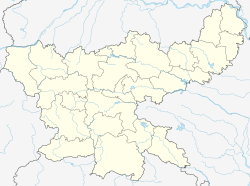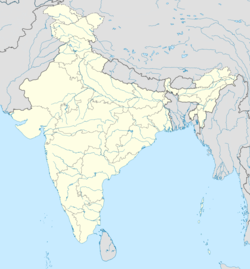|
Dhalbhum subdivision
Dhalbhum subdivision is an administrative subdivision of the East Singhbhum district in the Kolhan division in the state of Jharkhand, India. HistoryDhalbhum subdivision was created in 1920 with Jamshedpur as headquarters.[1] Administrative set upThe district consists of two subdivisions - (1) Dhalbhum subdivision with Patamda, Boram, Golmuri-cum-Jugsalai and Potka CD blocks, and (2) Ghatshila subdivision with Ghatshila, Dhalbhumgarh, Musabani, Dumaria, Gurbandha, Chakulia and Baharagora CD blocks.[2] The subdivisions of Purbi Singhbhum district have the following distinctions:[3]
Note: Calculated on the basis of block-wise data available. 
15km 10miles W E S
T
B E N G A L O D I
S
H A
Dalma Wildlife Sanctuary T
Kharkhai River
Subarnarekha River
Musabani CT
Jadugora CT
Haludpukur CT
Ghatshila CT
Galudih T
Burudi T
Chakuliya M
Jamshedpur M
Potka R
Patamda R
Mahulia R
Kokpara R
Hata R
Gurbandha R
Dumaria R
Boram R
Dhalbhumgarh R
Baharagora R Cities, towns and locations in East Singhbhum district in Kolhan Division (Locations around Jamshedpur are shown in the Jamshedpur Urban Agglomeration map - see Bagbera Colony page) M: municipality, R: rural/ urban centre, CT: census town, T: tourist centre Owing to space constraints in the small map, the actual locations in a larger map may vary slightly Police stationsPolice stations in the Dhalbhum subdivision are at:[4]
BlocksCommunity development blocks in the Dhalbhum subdivision are:[3]
EducationIn 2011, in Dhalbhum subdivision out of a total 523 inhabited villages in 4 CD blocks there were 38 villages with pre-primary schools, 479 villages with primary schools, 95 villages with middle schools, 40 villages with secondary schools, 5 villages with senior secondary schools, 44 villages with no educational facility.[5] The 3 statutory towns (Jamshedpur, Mango, Jugsalai) had 329 primary schools, 401 middle schools, 105 secondary schools, 16 senior secondary schools and 9 general degree colleges. 7 census towns had 84 primary schools, 38 middle schools, 23 secondary schools, 6 senior secondary schools, 1 general degree college. (Census towns are normally considered to be a part of the CD block but it is not clear where these are being considered here).[5]
Educational institutionsThe following institutions are located in Dhalbhum subdivision:
(Information about degree colleges in the subdivision with proper reference may be added here) HealthcareIn 2011, in Dhalbhum subdivision, in the 4 CD blocks, there were 6 villages with primary health centres, 55 villages with primary health subcentres, 15 villages with maternity and child welfare centres, 4 villages with allopathic hospitals, 7 villages with dispensaries, 7 villages with family welfare centres, 20 villages with medicine shops.[5] The 3 statutory towns in the subdivision had 29 hospitals, 43 nursing homes, 148 health centres, 148 dispensaries, 15 maternity and child welfare centres, 17 family welfare centres, 1,123 medicine shops. 7 census towns had 31 hospitals, 34 nursing homes, 30 dispensaries, 66 maternity and child welfare centres, 33 medicine shops. (Census towns are normally considered to be a part of the CD block but it is not clear where these are being considered here).
Medical facilities
(Anybody having referenced information about location of government/ private medical facilities may please add it here) References
|
||||||||||||||||||||||||||||||||||||||||||||||||||||||||||||||||||||||||||||||||||||||||||||||


